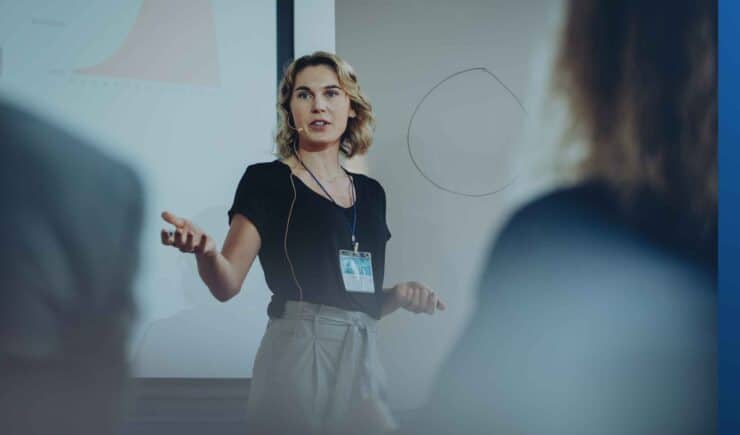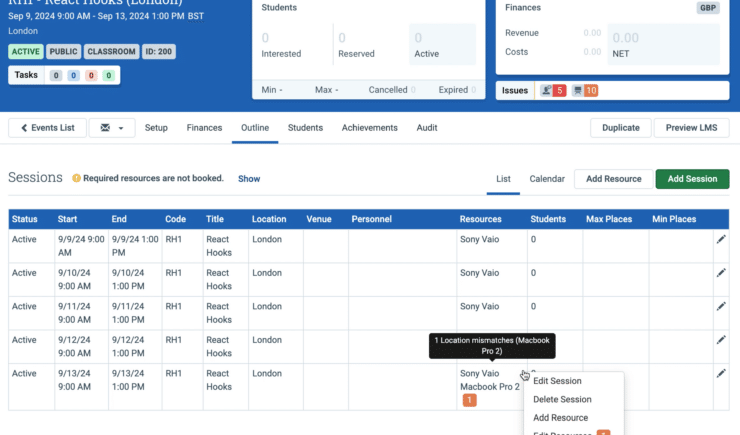Welcome to Training Management & COVID-19: Solutions for the Coronavirus Pandemic – a series of interviews with enterprise training leaders from around the world who are adapting the way they work. They’ll share some of the scenarios they’re facing, identity best practices, what’s working and what’s not, and we’re hopefully going to laugh a lot along the way as well.
My name is John Peebles, the CEO here at Administrate, and today I’m broadcasting to you from my home office in Edinburgh, Scotland, where we’ll be discussing training COVID-19 infrastructure, and how to respond to the unexpected with Jason Flowerday, the CEO of MDBriefCase.
Meet Jason Flowerday
Jason Flowerday is the CEO of MDBriefCase, a Canada-based organization that provides accredited, online continuing professional development (CPD) to help healthcare practitioners enhance their professional practice and stay at the forefront of the latest evidence and protocols.
I’m really excited to speak to Jason today, and it’ll be really interesting to see how their investments and infrastructure over the last 18 months have played out with their response to COVID-19.
Before you pop in your earbuds, be sure to subscribe to our blog to stay connected for future episodes. We’ll be publishing part three of our series next week!
All the best to you and your team as you navigate these rapidly changing times.
John Peebles
CEO of Administrate
[Listen time: 27 minutes]
Audio Transcript
(0:00)
John Peebles: I think the first time that we met, it was at your offices in Toronto. It was in the middle of a snowstorm. Now, I think we’re both not at our offices and in a different kind of storm. Why don’t you introduce yourself and your company, and tell us about what you’re seeing from where you sit as far as it goes with COVID-19?
Jason Flowerday: For sure. Thanks, John. I do recall it was about 18 months ago or 24 months ago. Certainly, we’ve moved into a different kind of chaos from typical Canadian weather, but from our point of view here at MDBriefCase, it’s unprecedented times in so many ways. Not to use such an overused phrase right now, but I can’t think of an instance where our members, really worldwide healthcare practitioners, have been taxed in a way that they are being taxed right now. And drawn upon in so many different ways to meet the needs of their stakeholders, largely patients, but also as a small organization of 50 or fewer people with operations in Canada, Europe, the Middle East, and Australia. It’s making for interesting times where people are pulling together as we’ve never seen before. There wasn’t a playbook for this, but I’m impressed with how the organization has pulled together and the leadership and the commitment they’ve all demonstrated.
John: You’ve got a unique platform in that you’ve got a huge amount of content that is segmented across different professions and areas of healthcare, and so on. That’s available for your members to access in normal times. How has that platform and that content and that access, those access patterns, how are those evolving now?
Jason: Our business, it’s really
(2:00)
unique in that in certain parts of the world, the concept of online medical education is a mainstay. In other parts of the world, the Middle East, in Asia, and some of the developing countries and continents that we’re working within, they’re just coming to understanding the benefits of online continuous professional development. It’s having a different sense of urgency and a different need to innovate in each of these regions, which is making for interesting times. Businesses that have traditionally been reliant on bringing together large groups and large audiences, which is common in healthcare to bring together large groups of doctors or nurses or pharmacists, they’re all scrambling and looking for a way to maintain the continuity of their engagement. When I say, “their engagement,” I mean traditionally large international or multinational pharmaceutical companies that have a desire to both educate and keep their physician and nurse and pharmacist audiences well-honed and well-tooled with the latest information available, not only to COVID-19 but also to whether it’s diabetes or heart failure or the management of asthma.
We’re seeing a lot of opportunity for innovation and the application of our platform, really essentially your platform, Administrate, which is the driver and the engine underneath everything we’re doing as an organization. There are going to be winners and losers through this, and I hate to sort of think of it through that way, but we’re trying to support an incredible number of key clients who have a need to stay engaged with their healthcare practitioner
(4:00)
audiences.
John: In the past, I think you’ve competed from time to time, maybe on the fringe, with more traditional forms of instruction, right? Where if I’m a medical professional, I might go somewhere and receive training in a class, and your offering has been different from that. How do you see that evolve? Do you feel like this is a time where maybe your organization has seen the future a bit, and it’s time to kind of get out there and shine?
Jason: For sure. I think that the view that our leadership team and our ownership group and, quite frankly, everybody through the organization has taken is this is an opportunity for MDBriefCase, probably unprecedented and completely unpredicted, and the view that we’ve taken is we are able to fill a huge void now where, in the past, you’re right, there was a lot of pressure to continue to keep very traditional learning formats of individuals coming together at large conferences or at grand rounds and seminars, and we’re seeing the cancellation of major, major international conferences. They could be in the oncology space; they could be within the diabetes space.
Right now, these cancellations are agnostic to the therapeutic area, to the region around the world and they’re all looking for partners, like MDBriefCase, to come to the table with ideas and opportunities that will allow the message that needs to be delivered to continue to reach these key audiences. We see it as a tremendous opportunity to quickly pivot and provide our client base and the physicians that rely on receiving the latest information with tools that we’ve had available for a long time.
(6:00)
But, now, I think people are quickly realizing this is the time and place. If you haven’t previously appreciated the benefits of distance learning, how and why this can allow you to stay at the top of what’s current and what’s evolving in whichever therapeutic area may be of interest to you. Whether it’s public health or whether it’s general medicine, or oncology, or respirology, the benefits of organizations like MDBriefCase and the distance learning that we provide has probably never been more evident and more appropriate.
John: And, one thing that we’ve noticed with our team is we, like many organizations, we have a global presence and so our eastern-more offices in the Middle East and here in the UK, we started closing down in advance of our North American offices. And when we did that, we did some tests where everybody worked from home for a day or two, but people were a little apprehensive about it. And now that we’ve been in this for four, or five, six, seven days, we’re getting questions like, “Well, are we even going to need an office in the future?” And I think that is similar to the approach in some cases with distance learning or eLearning where you haven’t done it before, so you decide you don’t like it but once you get involved and experience it, you’re like, “Hey, this works pretty well.” Are you seeing that with your users and customers?
Jason: Yeah, very much so. I mean, let me touch on your first point, which is we too had to make that difficult decision in terms of when history writes itself here, where do we want to be on having made the decision to close our offices down and did we have the necessary tools in place to be able to work remotely? And so, we made that decision fairly early in the process, now, just about a week ago
(8:00)
to ask all of our affiliates to institute a work from home policy immediately. And I guess I’m pleasantly surprised just how smooth that process has been. All reports are that there’s been no disruption to the workflow and the production of programs and educational material that our clients are still asking us about, and are they on track, and are they on time?
And to your second point, I think you’re right. I think that the extreme precautions that are being asked of everybody from, be it hospitals and decision-makers in the healthcare arena to provincial, federal, and state decision-makers are helping everybody realize the benefits of distance learning as being a viable and a very appropriate not only short-term solution but as you suggest, I think probably a long-term solution that’s here to stay where it wasn’t already a mainstay.
So in the different geographies that MDBriefCase has a strong foothold, if we look at a market like Canada, we’ve been market leaders in Canada for 20 years. Our opportunity within the United Kingdom and the EU5 is a newer area for us, but we’re continuing to establish that. A newer area would be the Middle East, where the adoption of online medical education is only two to three years old. But we’ve been leaders in that marketplace. And I think with the origins of where COVID-19 started and how it impacted some of these Middle Eastern countries, I think there’s a greater appreciation than ever for how this will benefit hundreds of thousands of workers that need this information. And, it’s also important that we
(10:00)
recognize, John, a lot of the contributors to our content and the development of our content are healthcare professionals themselves.
And so we’re trying to strike a balance between leaning too heavily on leaders within various fields who are also being faced with their demands of managing COVID-19 with the need to contribute to the programs that we’ve been asked to bring forward, high-value accredited educational programs. And so it’s the balance we’re trying to strike right now between meeting clients’ needs but also meeting the larger public need and not putting too much pressure on an organization and then on our systems that are already taxed. But, certainly, we’re seeing globally a greater appreciation for online distance learning. And it comes in a variety of formats, being a very viable, a very cost-effective mechanism for keeping people apprised of whether it’s the simplicities of hand-washing or of the latest evolution in diabetes management as very relevant and here to stay.
John: Yeah. And, I may be switching gears too for a second. There’s a lot of fear out there in the world right now today about the impacts of this and fears around the economy, and fears around various industries, and for loved ones, and folks that are working on the front lines of this. How have you addressed that with your team and with your organization? Because I know that’s been something we’ve had to think about and not obsess over, but it needs to be addressed with our company, with our team, and vendors, and suppliers, and so on. What are some of the things that you’ve been doing and your leadership team has been doing to address that and get out ahead of it and
(12:00)
make sure that folks are focused on the right things?
Jason: Oh, for sure. As I said, I think we feel we made an appropriate and early decision to ask people to practice all of the appropriate safety measures from hand washing and appropriate cough and sneeze procedures, and cleansing procedures at the workplace before we implemented a work from home policy. And the work from home policy, I think, was received with a sense of exhalation and appreciation from the workforce. Because our workforce is unique, and it varies in age. But people either have young children who are now most likely at home because of the closure of daycares and schools and pretty much all the jurisdictions that we work within.
But there’s also care for the elderly and parents, which is complicating situations. And I can speak to that from my own family’s situation. And the flexibility to be able to practice social distancing while working from home, and the advent of being on and off teleconferences, and various forms of technology to stay engaged, I think lends itself well to people having a reduced level of stress and anxiety, that they have to travel on public transit, into a workplace, that they don’t know the hygiene of. Where they can feel safer at home and have the flexibility to care for children and family members, or neighbors, for that matter, with their own community, it’s been well received. The question is, how long will it go on for? And it’s a $64,000 question, really. We’re remaining fluid and making decisions on a day-to-day basis based on what the experts in the field are advising us.
(14:00)
John: Yeah. One of the things that I know we’ve talked about in the past is there’s this idea maybe by folks who are outside of the training industry, that training is often just this reaction, right? And we do something new and react to it, we build training, and there you go. But I know we are passionate about the idea that training should be leadership, in many cases. What are some of your thoughts on that as far as MDBriefCase and how you’re approaching that in your product offering, and if you’re a trained professional that’s sitting out there listening to this, what would you counsel to them in terms of getting on the forefront of that leadership curve when there’s a situation like COVID-19 that is impacting a lot of folks in a lot of different ways.
Jason: That’s a good question, John. I think MDBriefCase is fortunate because the vast majority, if not all of our stakeholders, are leaders within the healthcare domain. They’re either international pharmaceutical companies or physicians with expertise in a particular therapeutic area. I think there’s a heightened sensitivity and a heightened appreciation for the growing importance of training. Perhaps in the past, training was considered to be discretionary, optional, after a company had checked a bunch of other boxes and implemented their marketing plans and clinical trial initiatives. If there was time and room and money and inclination, well, what could we do in the training front? And that’s not the case in all organizations, but certainly, there are a number of organizations that approach training in that manner.
I think training and what has happened in just
(16:00)
the short number of weeks that we’ve been truly facing COVID-19, the appreciation, and the leadership that those who have the ability to make training a priority are garnering within their own institutions. Because it’s probably now the leading vehicle, the leading channel where these stakeholders can do and accomplish so many different goals at one time. Practice what they preach in terms of all of the appropriate and safe measures while allowing their learners, doctors, nurses, pharmacists, allied healthcare professionals to learn from home or safely from hospital environments where they can take advantage of technology and truly do the right thing and be seen as doing the right thing. Leveraging partnerships with organizations like MDBriefCase, and doing it more proactively than they ever have in the past.
So, we’re being asked by a lot of these traditional and longstanding clients of ours to come up with even more new and innovative solutions that will allow healthcare professionals to receive information that they otherwise just wouldn’t be able to get access to. And that’s converting conferences to online formats, or bringing the latest in clinical studies that would otherwise have taken months, and months, and months to roll out to the field but can now be quickly disseminated through our platform and the various tools that we have to reach learners worldwide.
John: You’re right. And that compression of delivery is a huge challenge, I would imagine, but also where it can be a big differentiator if you’ve got those tools, if you’ve got your team set up, and that pipeline built to just compress the time between something that needs to be conceived and something that needs to be rolled out.
(18:00)
That is a real, real asset in times like this.
Jason: Yeah, absolutely. We recognize that our clients and those that rely on our clients to fund high-quality accredited education, everybody’s under pressure right now. Budgets are under pressure; people are working in unusual and new environments with new challenges that they’ve never faced before. And our view on this is really not to see this as an opportunity to gouge anybody, but really to partner with them and demonstrate our commitment and do it very fairly on the best economic terms possible. So that we can deepen the partnerships that we’ve had with so many of these organizations and built up over the last 10 or 20 years, and be viewed as a true partner, as we’ve tried to demonstrate all along.
I think now more than ever; organizations are appreciating that and turning to us for new ideas and ways. You’re right, that time compression and the turnaround can be days or a couple of weeks as opposed to perhaps months where it was in the past. And we can forego with some formality while we still ensure the very high-quality development and delivery of content that MDBriefCase has always been known for. And I think organizations that we work with share that view, where their reputation is also on the line. And they want to do the right thing. Because that’s what they’ve always done and that’s what’s expected in these times of stress and unfamiliarity for everybody.
John: Yeah, I really like the idea of foregoing formality but still retaining quality. I want to use that, I think. That’s a really good one. Our team has been experiencing that as well. But if you’ve got the right infrastructure
(20:00)
and the right team in place, then you’ve got the tools to do that.
Jason: Yeah, that’s it. We’re trying to push decision making within the organization as deep and all the way through the organization as we can. Because with the number of one-offs and exceptions and decisions that are rising up to the top, there just isn’t enough time for our leadership team to be involved in every decision. But I think they’ve set a tone and they’ve set an expectation that everybody knows what the goal is. There’s alignment around the overall objective. And everybody’s being empowered to innovate and try to engage in what our client’s needs are and bring forward ideas that are going to meet the needs of these clients in as short a time frame as possible.
So far, it seems to be working, and we’re excited about the work we’re undertaking now and our abilities to continue to deliver projects worldwide, as well as to take on new initiatives at a pace that we’ve never seen before.
John: So, if I’m a training professional that’s listening to you, and I’m sitting there thinking, “Man, this company, they were already on the forefront of the modality of learning, in terms of not having classrooms with physical desks and so on,” it sounds like you invested a lot in your platform. I don’t have any of those things. I’m now maybe feeling a little bit demoralized or behind the curve. It’s probably a feeling that we’ve all shared to one degree or other, the last week or two, being behind the curve. What would you say to somebody like that who might be listening in? What’s the best place to start to get to the point where you can have that maneuverability and flexibility?
(22:00)
Jason: If it’s an organization that’s within the healthcare space, MDBriefCase is one of many organizations that I think is trying to role model the right approach here in distance learning. The work that we’ve done with you guys at Administrate has really transformed our business in the last couple of years and allowed us to adapt and pivot more quickly than we’ve ever been able to in the past. We have a roster of products and services that are a lot more turnkey and give us the ability to get them out the door more consistently with the same high quality that is expected through and through every program that we deliver.
But if organizations haven’t been accustomed to that in the past, I don’t think it takes a lot of research and a lot of digging to find the leaders in your own field. In healthcare, we view ourselves as a leader. But if I were to be searching for solutions in another area, I don’t think it’d be too hard to come across organizations like Administrate that have been leading the field for a number of years and can provide a solution that’s cost-effective that allows the organization’s mandate to be a leader in training and development to either flourish or continue.
So, I think this is a time where training and development, whatever field you’re involved in, is an opportunity and is an area of focus that business leaders are appreciating more so than ever. And we’re certainly seeing that be the case in the healthcare area where we have all of our familiarity. And I think it’s an opportune time to be in this space. And those that are well entrenched in distance learning and online learning, I think, will come out really well through this and hopefully having
(24:00)
added to the flattening of the curve and a return to normalcy.
John: That sounds great, and I appreciate your time, Jason. And we wish you all the best, and we’re rooting for you. And we’ve enjoyed the partnership over the last, man, it feels like it’s not been very long at all, but it’s getting onto, as you said almost two years. And I appreciate your insights today.
Jason: John, pleasure. Appreciate it, and I wish you guys and your team at Administrate all the best as you work with organizations like ours and organizations around the world to push forward on something that I think is actually going to make a meaningful and material difference to how quickly we’re able to get back to normal. It’ll be a new normal for sure. But I think it’s one in which training and development and online education are going to play a much more significant role in the lives of individuals and organizations, regardless of what industry you’re in. So, thanks for the chance to chat with you today. I hope you and your team are well.
Is your organization faced with a need to convert in-person training to virtual training events?
We can help. Check out Administrate’s new vILT Rapid Implementation option.
Your live training events could go online in as little as five business days.
Listen to more in the series:
Training Management & COVID-19: Solutions for the Coronavirus Pandemic – Part one
Training Management & COVID-19: Solutions for the Coronavirus Pandemic – Part three
Training Management & COVID-19: Solutions for the Coronavirus Pandemic – Part four





